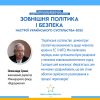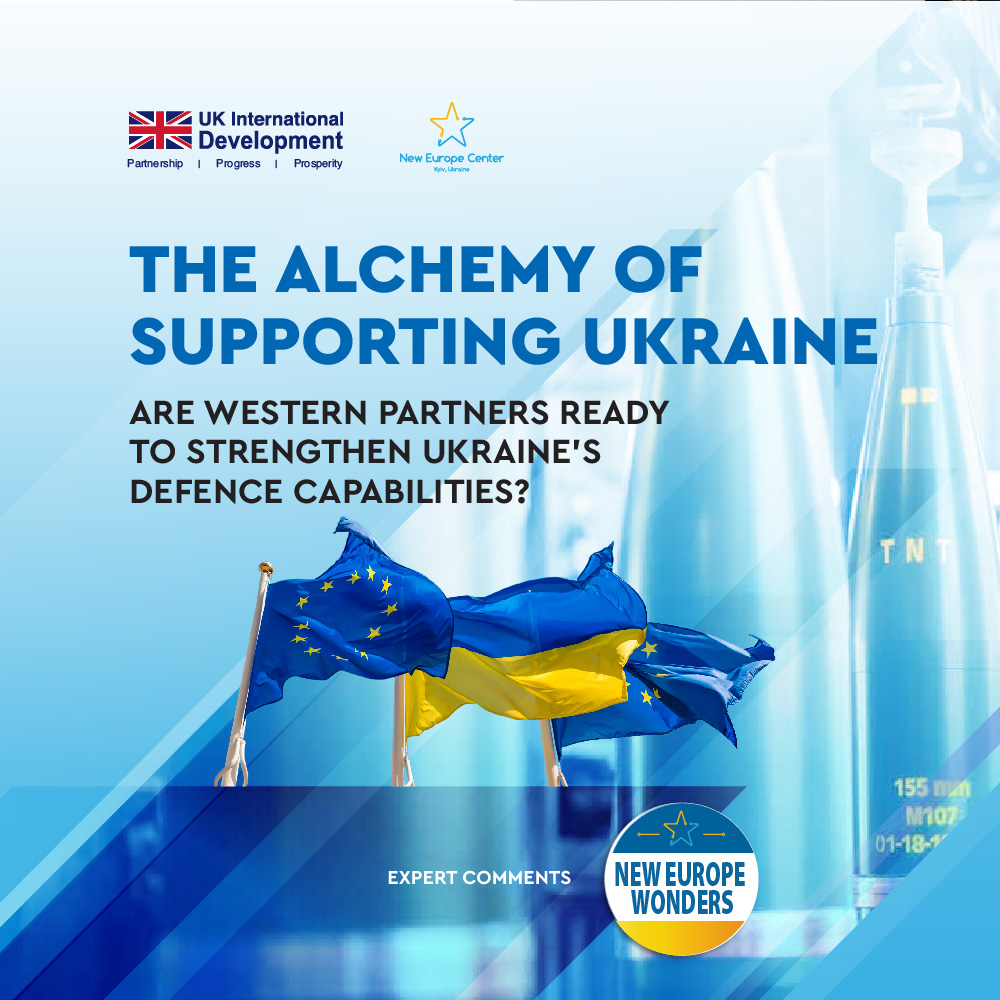
In the context of the protracted war with Russia and unstable military supplies, the issue of investment in Ukraine’s defense industry is becoming increasingly relevant. Many countries have already declared their readiness to invest in arms production in Ukraine. And this interest, it seems, will only continue to grow. However, there are many challenges standing in the way. In this regard, the New Europe Center turned to leading Ukrainian and international experts with the following question: “How would you assess the current readiness and commitment of Ukraine’s Western partners – particularly within the EU – to strengthen Ukraine’s defense capabilities in the short to medium term, whether through joint production, direct investment, or the provision of military equipment; and what factors currently enable or could further facilitate such engagement in Ukraine’s defense-industrial sector?”
Key Findings:
- Ukraine is becoming an equal partner of Europe in security.
The EU recognizes the value of Ukraine’s combat experience and innovations. The creation of joint missile defense and air defense systems, defense capacities, and the integration of Ukrainian companies into European programs (such as SAFE) will strengthen the defense of both sides.
- Investing in weapons production is the path to resilience.
Investments in technology and production will ensure long-term support and accelerate innovation. However, for stable progress, Ukraine needs to improve its business environment.
- The main structural problem is the fragmentation of Europe’s defense industry.
Although Europe’s combined GDP is 12 times larger than Russia’s, the lack of production scale and political determination prevents this advantage from being realized. Underfunding and insufficient integration of the defense industry leave Europe dependent on the United States.
- Ukraine needs weapons now – and this must be the top priority.
While structural reforms of the defense industry are important, for Ukraine the key issue is the rapid increase in weapons supplies to preserve defense capability. Europe will have to work in parallel on both long-term investments and urgent solutions.
- The lack of production capacity requires combined solutions.
The West’s biggest problem is insufficient production capacity, so it is necessary to combine U.S. purchases, investments in Ukraine, and a “coalition of the willing.” Joint production in Ukraine not only fills the gaps but also allows Europe to learn from the unique experience of modern warfare, strengthening its defense capability and reducing dependence on the U.S.
- Europe has a chance to become a leader in supporting Ukraine.
If political hesitation and bureaucracy can be overcome, weapons production can be rapidly accelerated. Ukraine has a flexible defense industry and necessary experience, but scaling up requires EU resources, technologies, and investments.
- Bureaucracy remains the main obstacle to joint projects.
The biggest barrier is bureaucracy, which slows down joint defense projects and creates risks for partnership. Europe has the resources, while Ukraine has the technology and combat experience, but slow procedures and attempts to move production outside Ukraine threaten equal cooperation.
- Northern Europe is becoming the driver of defense cooperation with Ukraine.
Other countries show interest in applying the “Danish model”[1] of direct procurement and joint production with Ukraine. Sweden, Norway, and Denmark demonstrate strategic leadership. To maintain momentum, more funding, better EU and NATO coordination, and guarantees for investment security are needed.
James Sherr, Honorary Fellow, International Centre of Defence & Security (Tallinn)
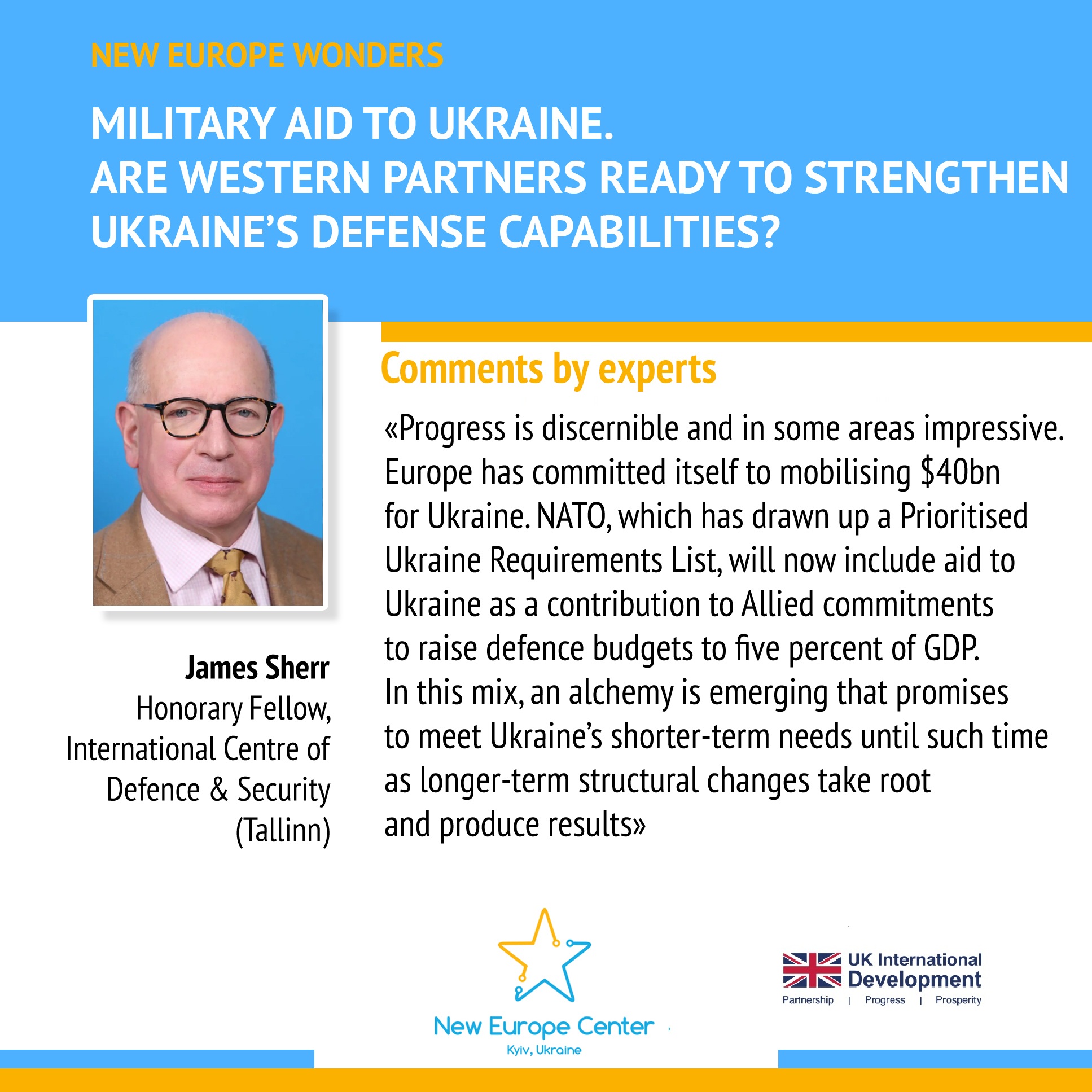
Since its inception, the greatest accomplishment of the European Union has been to make war between its members impossible. But the defence of Europe from external threats has been a Transatlantic endeavour, and that is also true for the defence of Ukraine. Donald Trump has rudely put the future of both enterprises in doubt. Does Europe possess the means, the cohesion and the mindset to rise to the occasion and do so before Ukraine is irretrievably damaged?
The good news is that, today at least, a clear majority of European governments and defence establishments believe there is an axiomatic equation between Ukraine’s defence and their own. But electorates do not necessarily share these convictions. Which is more telling: plans to double German defence expenditure by 2029 or the fragility of Chancellor Merz’s coalition? Emmanuel Macron’s toughness towards Russia is conspicuous, but his domestic base has sharply contracted, and the electoral ban on Marine Le Pen’s participation in the 2027 elections has hardly damaged the popularity of her Rassemblement National at all. Yet amongst the ‘E3’, the biggest earthquake might come in the UK, where the pugnaciously anti-EU, Russophile Reform Party stands a good chance of becoming the largest party in Parliament after the next election. Electorates might support populist parties for reasons largely unrelated to Russia (e.g. immigration), but that does not limit the damage these parties might inflict if they come to power.
Even if the centre ground holds, important hurdles need to be cleared before European military assistance to Ukraine reaches its full potential. As Ukraine’s leadership constantly reminds us, Russia poses a danger to Europe’s security as well as Ukraine’s. But where should priorities be focused? The UK has been Europe’s biggest supplier of military assistance to Ukraine, but resources earmarked for UK home defence and other important interests (the Arctic, the Baltic, the Red Sea and Gulf) are inadequate if not alarming. Are we making the right tradeoffs? Poland, Finland and Germany confront similar questions.
Moreover, Europe needs to balance the long-term imperative of constructing an integrated, cutting-edge defence industry and meeting Ukraine’s most immediate and urgent needs. Only now is Europe addressing the chronic underfunding that has whittled away its defences since the Cold War. Yet funding is not enough. The greatest deficiency of Europe’s defence industrial base is fragmentation, which obstructs economies of scale and production in volumes that transform a GDP (EEA plus UK) twelve times larger that of Russia into useable military power and offsets the all but inevitable diminution of the US presence. This will not be addressed without political courage and profound and very costly structural change. Yet Ukraine’s most acute challenges are short-term. Europe, therefore, cannot sidestep the imperative of surging supply of the weapons systems that Ukraine needs now to shore up the integrity of its defences.
A no less critical imbalance is Europe’s deficiency of vital enablers — airlift, future generation technologies, strategic communications, intelligence and long-range strike systems — that preserve chronic dependencies on the United States. Investments designed to lessen these dependencies are offset by others — e.g. British procurement of nuclear capable American F-35As — that merely perpetuate them. Repeatedly, widely proclaimed objectives — e.g. an Anglo-French ‘reassurance force’ for Ukraine — founder on the realization that resources are simply unavailable. The UK’s 2025 Strategic Defence Review is a far-sighted and admirably coherent document. But it offers not even a hint as to how the requisite programmes and capabilities are to be funded.
Today, these challenges are understood in ways that would not have been possible in 2022. Progress is discernible and in some areas impressive. Europe has committed itself to mobilising $40bn for Ukraine, offsetting the US share. Moreover, the US has agreed in principle to provide as much assistance to Ukraine as the European tax payer is willing to fund. NATO, which has drawn up a Prioritised Ukraine Requirements List, will now include aid to Ukraine as a contribution to Allied commitments to raise defence budgets to five percent of GDP. Plans will make provision for radar and jamming systems, drone interceptors and artillery, funded nationally by Europe and coordinated by NATO, bypassing the EU’s cumbersome procedures. In this mix, an alchemy is emerging that promises to meet Ukraine’s shorter-term needs until such time as longer-term structural changes take root and produce results. Not least important, Allies now recognise that partnership with Ukraine’s technological and industrial base advances both parties’ interests.
The imperatives of speed, innovation and structural change are becoming generally understood. But we cannot yet be confident that these challenges will be surmounted.
Carsten Soendergaard, Ambassador of Denmark (ret)
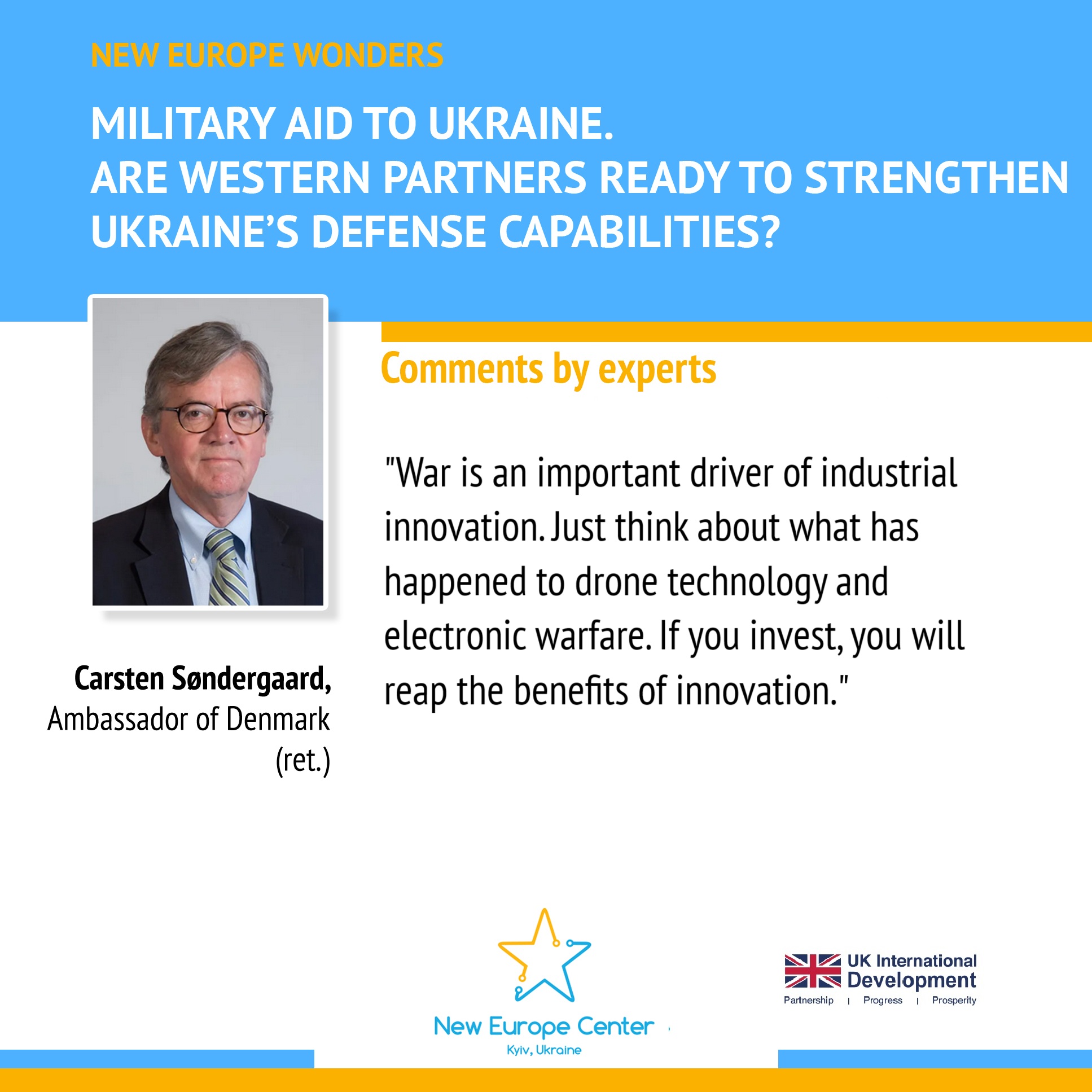
Western support has undergone changes since Russia launched its brutal invasion of Ukraine, but still some Western countries do much more than others. So, how can the support be increased?
Today, the USA is moving away from donating some military equipment to selling it. A group of countries still does not show any significant interest in supporting Ukraine. Donations are small. Another group continues to donate equipment, but it also moves beyond that. They buy new and better equipment. They invest in industries in Ukraine.
Ukraine faces a long-term existential threat. It makes sense for the West to invest in its industrial basis. That can be done with both public and private capital – both in Ukraine and in European countries.
War is an important driver of industrial innovation. Just think about what has happened to drone technology and electronic warfare. If you invest, you will reap the benefits of innovation.
Investment paves the way for a two-way street. It will increase predictability – no stop and go. But – and there is a but. For this process to move forward, Ukraine will have to improve the business environment. Doubts about Ukraine’s willingness to fight corruption are not helpful at all.
András Rácz, Senior Fellow, German Council on Foreign Relations (DGAP)
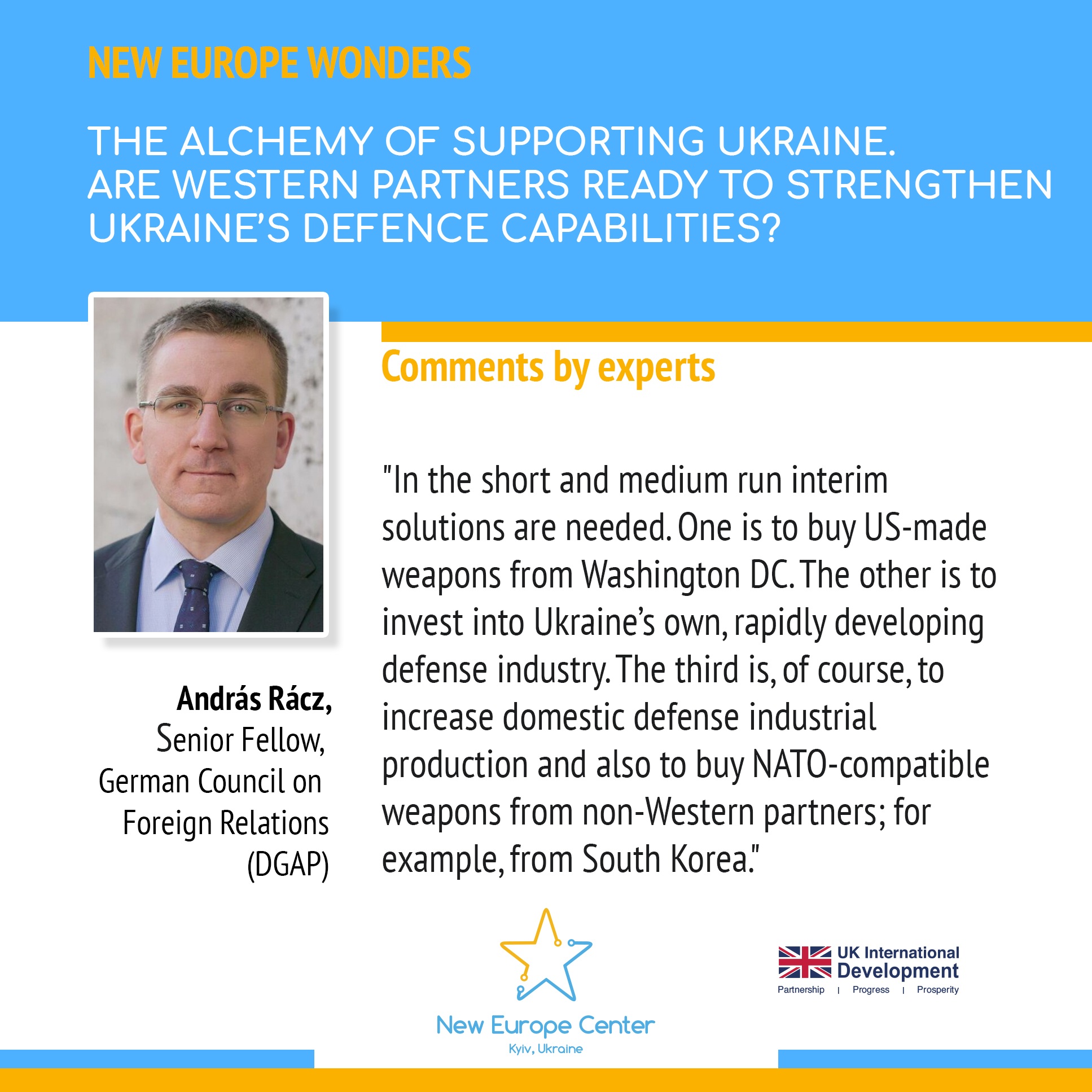
The political will to maintain comprehensive support for Ukraine is firmly present in Europe. Most Western-European countries clearly understand the need to keep up the support for Ukraine, regarding all the humanitarian, economic and also military support. This prevailing public backing of supporting Ukraine has been proven by the Eurobarometer surveys (the latest one is available here). As of spring 2025, throughout the entire EU, altogether 59% of the population supports the idea of purchasing weapons for Ukraine, while the support for economic and humanitarian backing is even higher.
The most important weakness of the West in this regard is not political, but technical. The problem with supporting Ukraine militarily is that the stockpiles of pre-2022 weaponry are running low. The weaponry and ammunition that was off-shelf available in times of the full-scale invasion has already been given to Ukraine. To make things worse, defense industrial production of heavy weaponry is not growing fast enough. The situation is a lot better than it was in 2022-2023, but production capabilities are not yet matching the demands of the war. While in the field of artillery ammunition production considerable improvements have been made, in terms of heavy weaponry, particularly tanks, IFVs and artillery Western-European countries still cannot produce enough to meet both the demands of both Ukraine as well as of other allied countries. The situation is particularly serious regarding air defense missiles. In two-three years from now the situation will be a lot better, as new production facilities will come online, but at present we are not yet there.
Hence, in the short and medium run interim solutions are needed. One is to buy US-made weapons from Washington DC. The other is to invest into Ukraine’s own, rapidly developing defense industry. The third is, of course, to increase domestic defense industrial production and also to buy NATO-compatible weapons from non-Western partners; for example, from South Korea.
The main benefit of these, already functioning interim solutions is that they are all immune to veto threats by one or more EU and NATO member countries. The reason is that these short and medium-term initiatives are running on a ‘coalition of the willing’ basis. The countries willing to contribute are doing so, while others are neither obliged to do so, nor do they have the veto power to block the entire process. With other words, this ‘coalition of the willing” format is much more resilient than consensus-based, EU and NATO mechanisms are.
Besides, investing into Ukraine’s defense industry and jointly producing weapons systems enable European companies to directly learn from Ukraine’s war experiences, to integrate the lessons learned in combat into future development projects. The possibility of learning from Ukraine is, in fact, constitutes a major advantage, if Europe is ready to learn the lessons, including also the inconvenient ones.
Nevertheless, one needs to see clearly: sustained, long-term efforts are needed. Even if the intensity of fighting in Ukraine will once subside, Russia will not cease to be an aggressive, imperialistic power in Europe’s neighbourhood. The threat from the Kremlin will prevail. Hence, Europe needs to prepare for facing a possible Russian military aggression already only a few years after the war in Ukraine ends.
Meanwhile, however, as long as Ukraine is fighting and defending herself, Russia is unable to open another front, unable to attack any NATO country. Every day by which Ukraine fights longer, every Russian soldier that Ukraine neutralizes is buying time for Europe. Ukraine is defending not only herself, but also the European Union. Hence, it is in the essential interest of Europe not to let Ukraine down, not to abandon Ukraine, even if the United States occasionally contemplates with the idea. The European EU and NATO countries need to stay firmly by Ukraine’s side, support her and learn from her at the same time.
Mykhailo Samus, Director, New Geopolitics Research Network
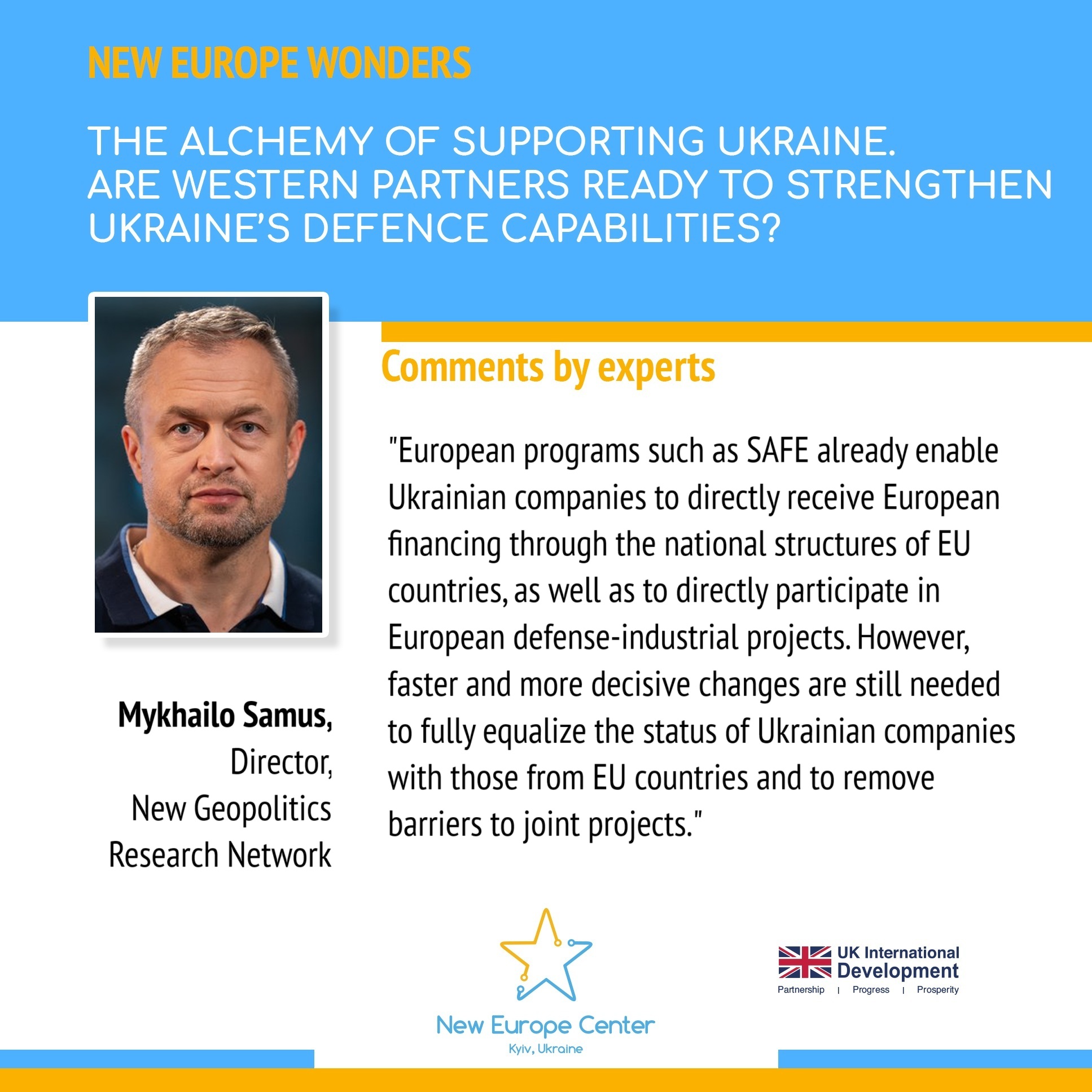
The formation of the EU countries’ readiness to strengthen Ukraine’s defense capability is progressing irregularly, yet steadily, with a gradual expansion of the practical dimension of this process. Overall, there is an evolution in Europe’s perception of Ukraine in the security and defense sphere: from a recipient in need of assistance to an equal partner possessing unique combat experience, from whom one can learn how to develop new doctrines of warfare, implement structural adaptations of the armed forces, and acquire advanced battlefield-tested technologies.
It is also important that European capitals recognize the necessity of building joint combat capabilities for Europe (including Ukraine) to deter aggressive Russia. Creating a joint missile defense and air defense system, ensuring a sufficient stock of cruise and ballistic missiles, developing joint defense-industrial capacities, and even shaping a joint nuclear doctrine for Europe – all of this requires a coordinated approach both within EU countries and with Ukraine.
European programs such as SAFE already enable Ukrainian companies to directly receive European financing through the national structures of EU countries, as well as to directly participate in European defense-industrial projects. However, faster and more decisive changes are still needed to fully equalize the status of Ukrainian companies with those from EU countries and to remove barriers to joint projects.
Special attention must also be paid to ensuring the subjectivity of Ukrainian companies in the field of intellectual property when implementing joint projects with European partners. In addition, new communication platforms are needed to support projects between EU countries and Ukraine, where future partners can obtain the necessary support to better understand each other in order to achieve success in the interests of both Armed Forces of Ukraine and European armies.
Klara Lindström, Analyst, Stockholm Centre for Eastern European Studies (SCEEUS)
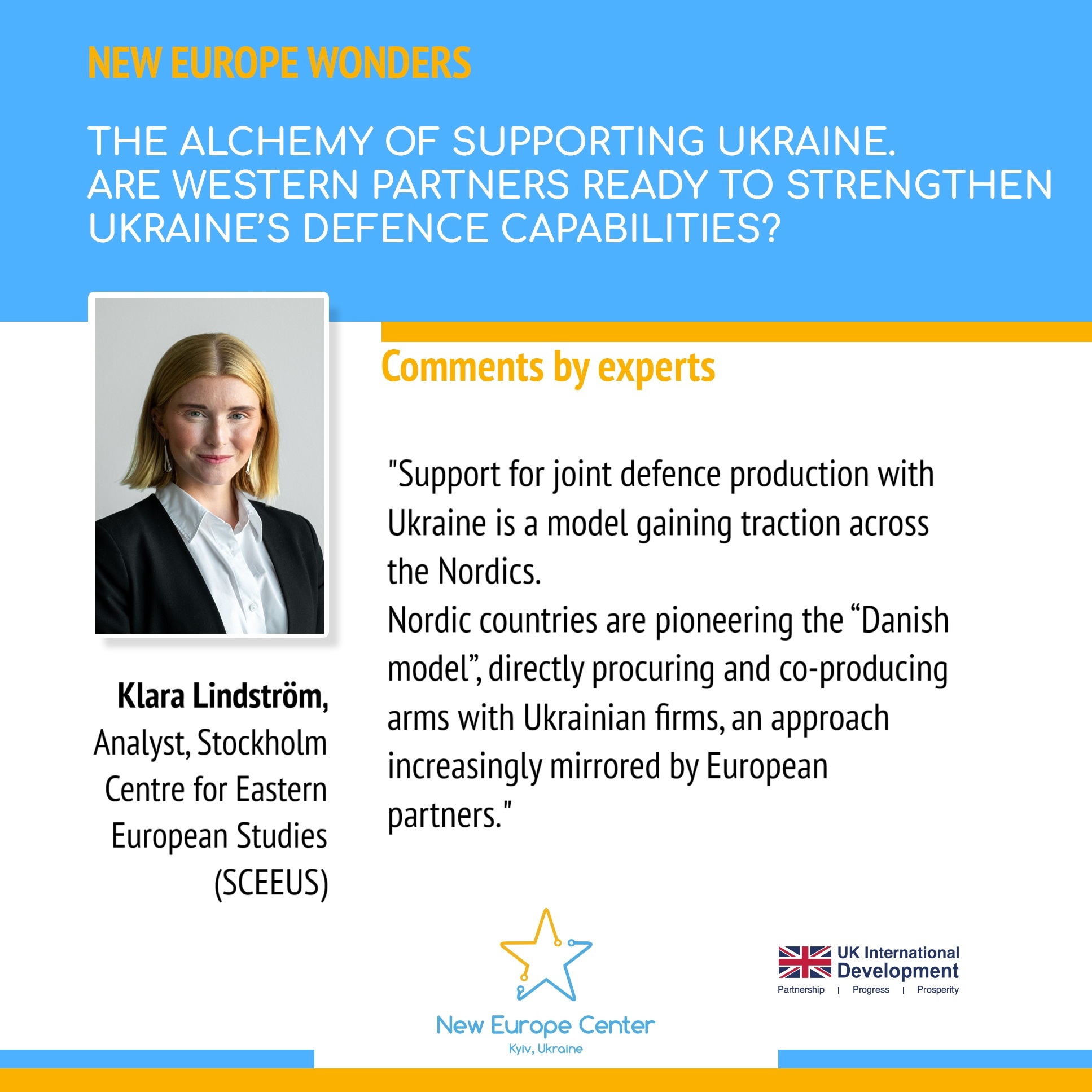
Ukraine’s European partners are showing increasing readiness and commitment to strengthening Ukraine’s defence capabilities, with the Nordic countries taking a particularly forward-leaning role. For example, Sweden, Norway, and Denmark have recently announced a joint package worth USD 500 million to provide prioritised American weapons to Ukraine through NATO under the new NATO Prioritised Ukraine Requirements List (PURL) initiative.
Support for joint defence production with Ukraine is a model gaining traction across the Nordics. Nordic countries are pioneering the “Danish model”, directly procuring and co-producing arms with Ukrainian firms, an approach increasingly mirrored by European partners. The
The Nordic commitment is underpinned by several factors: shared threat perception, robust bilateral security agreements, and innovative financing tools like Denmark’s state-backed guarantees for companies investing in Ukraine’s defence sector. Joint ventures and localised production are further facilitated by Ukraine’s battlefield-tested defence innovations and new legal frameworks promoting partner investment. Sustaining momentum will require scaling up funding, accelerating EU-NATO coordination, and bolstering investment security. The Nordic commitment, however, remains both durable and determined.
Mykhailo Gonchar, President of the Center for Global Studies “Strategy XXI”
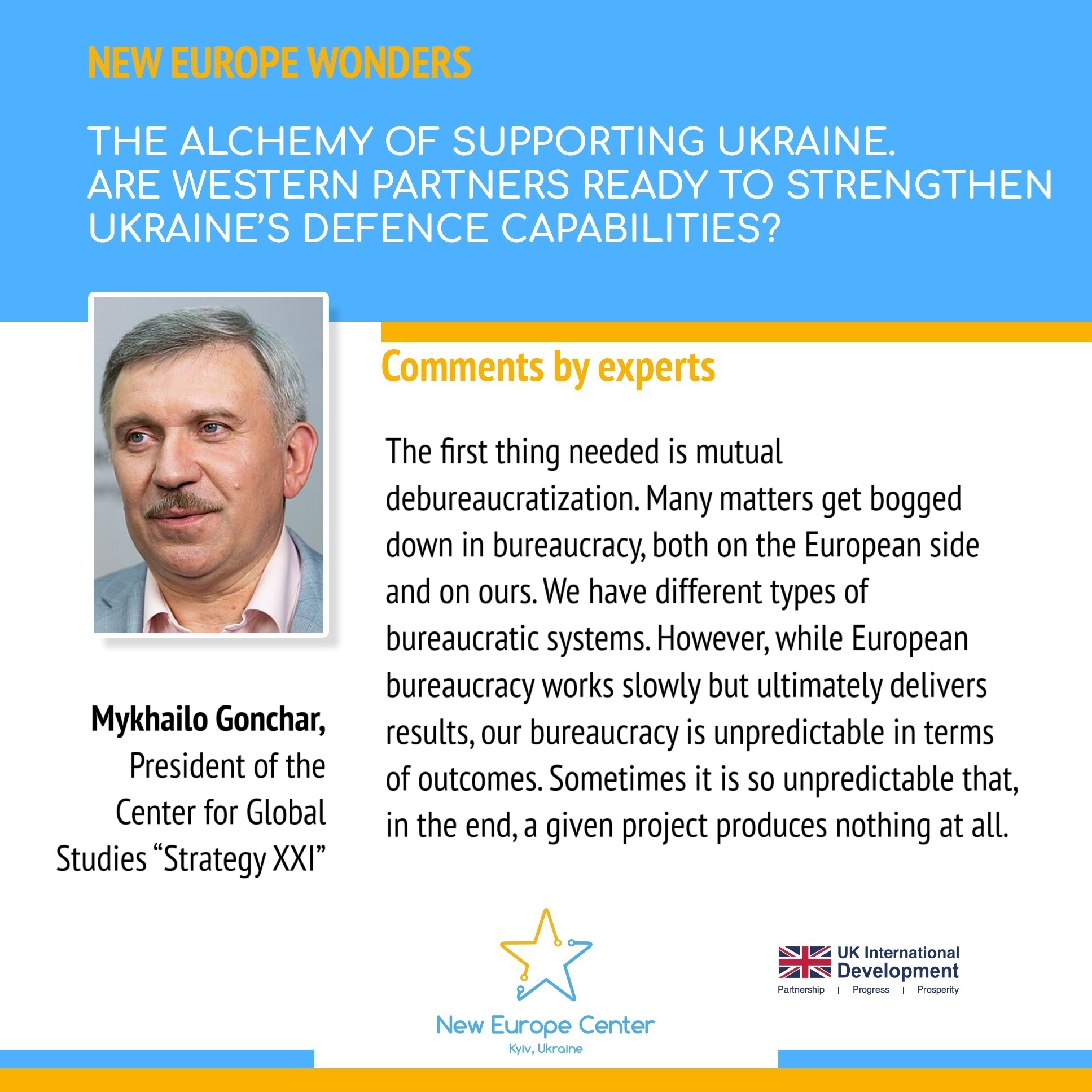
The first thing needed is mutual debureaucratization. Many matters get bogged down in bureaucracy, both on the European side and on ours. We have different types of bureaucratic systems. However, while European bureaucracy works slowly but ultimately delivers results, our bureaucracy is unpredictable in terms of outcomes. Sometimes it is so unpredictable that, in the end, a given project produces nothing at all.
A vivid example we see now is the German concern Rheinmetall, which recently expressed dissatisfaction with the “excessive Ukrainian bureaucracy” slowing down the construction of a domestic plant for artillery shell production. In Germany, such a plant is already operational, whereas in Ukraine, it is not.
Europe has money; we have developed technologies, know-how, and battlefield experience, which allow us to factor in lessons learned in subsequent production series of various systems. This is something Europeans lack. In addition, production costs here are significantly lower – and that also has a serious impact. On the one hand, the European defense industry naturally wants to secure funding to expand its own production. On the other, given our production costs, they are simply not competitive. Therefore, of course, it makes more sense to produce here.
At present, there is an attempt to harmonize the capabilities of both sides – with one side having the money and the other having the necessary technologies, know-how, and operational experience. It was assumed that this could be done fairly quickly, but it turns out it is not happening as fast as expected. Moreover, another trend is now becoming apparent – the attempt to gain access to Ukrainian production technological know-how, the technologies we have already developed that enable lower production costs, but then to carry out this production somewhere in European countries. This is not the behavior of a partner. It is often explained by the security risks for manufacturers, but on the other hand, it simply looks like an attempt at theft.
Leonid Litra, Senior Research Fellow at New Europe Center, Visiting Fellow at ECFR, Ukraine
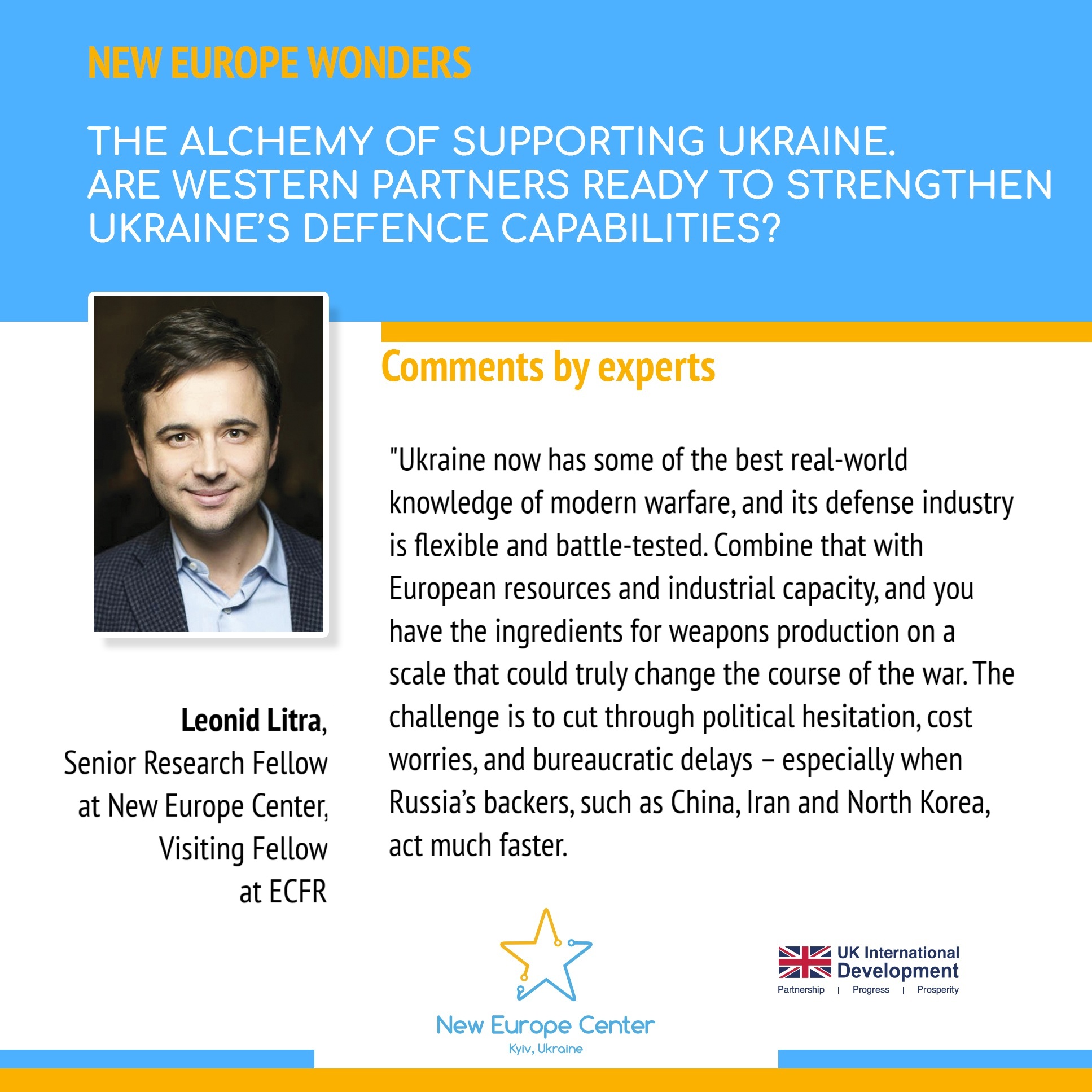
Over the past 40 months of full-scale war, Ukraine’s Western partners – especially in the EU – have played a vital role in helping the country hold the line against Russian aggression. The U.S. has been a crucial supplier of weapons, but with Washington’s commitment starting to waver, Europe is being pushed into a position where it may have to take the lead. That’s not an easy task, but it is possible if EU states make the most of their own stocks, ramp up production, and, where needed, buy from outside the bloc.
Right now, Europe’s commitment is real, but its readiness is uneven. Some countries have stepped up with major deliveries and bigger defence budgets. Others remain more cautious. The EU’s defence industry is still catching up after decades of underinvestment, and while production is increasing, it’s not yet fast enough to match battlefield demands.
For Ukraine to push the Russians back, three things matter most: speed, scale, and advanced technology. Ukraine can’t achieve all three on its own—it needs Western money, tech, and production power to unlock its full potential. Joint production lines in Ukraine, direct investment in its defense sector, and quicker export approvals could all make a big difference.
There are strong foundations to build on. Ukraine now has some of the best real-world knowledge of modern warfare, and its defense industry is flexible and battle-tested. Combine that with European resources and industrial capacity, and you have the ingredients for weapons production on a scale that could truly change the course of the war. The challenge is to cut through political hesitation, cost worries, and bureaucratic delays – especially when Russia’s backers, such as China, Iran and North Korea, act much faster.
If Europe can move from slow consensus to decisive action, it will not only help Ukraine defend itself but also strengthen the security of the entire continent.
[1] The “Danish model” is a financing mechanism in which partner governments, including Denmark, directly fund the procurement of weapons and military equipment from Ukrainian manufacturers.
PDF-version is here.
This material was funded by the UK government as part of the “Mutual Transformative Power: changing Ukraine through cooperation with wider Europe” project, implemented by the New Europe Center. The views expressed in this material are those of the author(s) and may not coincide with the official position of the UK government.




